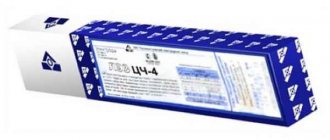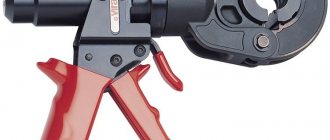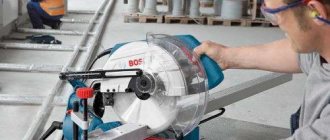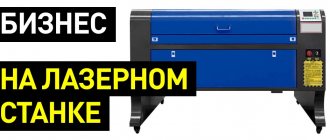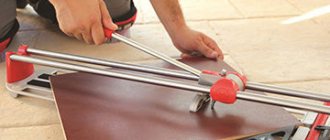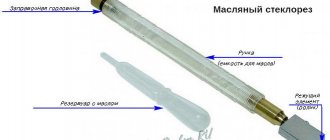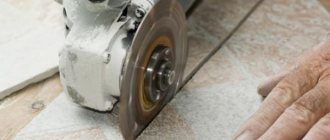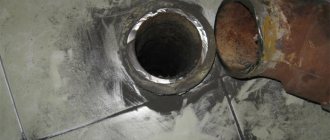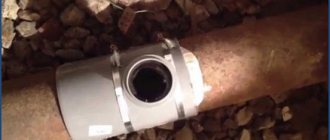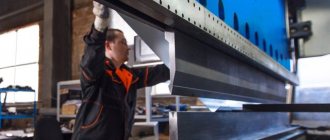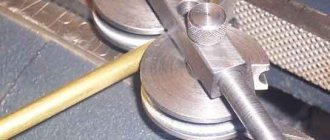Material cutting methods
As with any metal, methods for cutting cast iron are divided into thermal and mechanical. The choice of a specific tool depends on the design features. The following is equipment that saws (or cuts) cast iron:
- pipe cutter;
- angle grinder;
- chisel;
- hacksaw for metal;
- jigsaw
- plasma installation;
- gas cutters.
Now it’s worth evaluating cutting using the mentioned tools with objects made of cast iron.
Properties of cast iron
Cast iron refers to alloys that are formed by combining iron with carbon. The degree of doping with carbon impurities is more than 2%. Alloys that contain from 0.5% to 5% silicon, as well as 4% carbon, and from 0.2% to 1.5% manganese are very popular. Depending on the chemical composition, cast iron alloys are divided into unalloyed and alloyed. In this case, according to its structure, the alloy is divided into gray and white. Gray is characterized by a specific color in the fracture, which is formed due to carbon, which can be in the form of graphite or in a free state. In white material, the fracture has a characteristic light shade. In this case, almost all the carbon that is present in the alloy as an impurity is in a bound state. The properties of the alloy depend on individual conditions, which include not only the chemical composition of the products, but also the cooling rate of the finished cast iron after manufacturing. Gray cast iron and products based on it are widely used in industry.
Pipe cutter
This is a special device for cutting pipes from different materials. There are manual (mechanical) and electric tools. Both types are suitable for diameters 15-360 mm.
First, a carbide disk is mounted on the device. The removable element has a number of advantages over classic abrasive ones. For example, the cutting speed is increased by 4 times, there is no sparking and no need to add any substances to the cutting zone. Diamond coating is applied on top of the cutting edge, which extends the service life of the products. Examples of pipe cutters for cast iron pipes are portable Exact Pipecut products for diameters less than 360 mm.
Alas, it is rare that a home pipeline can be easily cut with a pipe cutter. It may be difficult for a tool to access it, or the cutting area may be bent so that it cannot be grasped by the device. Therefore, it is worth considering other options.
The essence of oxygen-flux metal cutting
Traditional cutting is not suitable for all materials. For example, steel alloyed with chromium and nickel is difficult to cut. A similar problem arises when cutting non-ferrous metals and cast iron.
Then oxygen-flux technology comes to the rescue. Its essence is as follows. Flux powder is supplied to the cutting zone. During the cutting process, this substance ignites and burns, releasing a large amount of heat, which makes it possible to melt refractory carbides, borides and metal oxides.
Angle grinder
Working with an angle grinder is quick and convenient, but not without its drawbacks. For example, it only cuts in a straight line. An attempt to make a curved cut will result in the disc being “bitten”, breaking, and possible injury to the user. Therefore, the machine is used for straight cutting. Another disadvantage is the fire hazard of the method (abrasive disc + metal = sparking). Before work, you will have to wear goggles, protection for your face and hands.
Cutting with a circle is more efficient than with a jigsaw, which is why users often choose a noisy grinder. When buying a cutting wheel, prefer products with a bakelite bond, because they are much stronger than their ceramic counterparts.
Basic safety rules
Before cutting wood with a grinder, you need to familiarize yourself with the safety rules. The main ones of these rules are the following:
- Be sure to use personal protective equipment (safety plastic goggles, fabric gloves) and work in overalls.
- It is strictly forbidden to use discs that have defects.
- It is recommended to hold the grinder firmly with 2 hands.
- Always ensure that the electrical cord is not near the rotating disc.
- Place the grinder only after the cutting element has completely stopped.
- Do not remove the protective cover.
- Do not work while intoxicated.
Working with a chisel and hammer
This pair of products will help separate cast iron in hard-to-reach places. Dismantling work begins with pipes remote from the riser in places where a grinder or hacksaw cannot be inserted. Since cast iron is a brittle material, it is easily destroyed after point dynamic loads.
A good impact tool has a rubber or polymer attachment to slightly soften the impact. This is necessary so that pieces of cast iron do not fly around, get into the riser and create a blockage.
The chisel and hammer work great with Soviet-era cast iron, that is, combined with sulfur, aluminum and cement. As you move towards the riser, there is usually more free space for work, so further cast iron can be cut with a more efficient device. As with the grinder, when working with a chisel, it is recommended to cover areas of the body into which cast iron splinters may fly off.
The productivity of work is extremely low, but sometimes you can’t do without them.
Sanding and polishing
For grinding and polishing wooden products, there is no better tool than an angle grinder, because... it has good performance and is able to provide high quality work performed. Using a grinder, you can perform the entire cycle of operations on processing wooden surfaces: from rough processing to final polishing.
To perform this work, special grinding attachments are used. The quality of the product depends on how correctly the circle for the grinder is selected. These attachments vary in shape, material and purpose.
For roughing (grinding) the following types of attachments are used:
- grinding wheel - a steel disk onto which pieces of metal wire are soldered;
- cord brush - a disc with wire bristles (available in different hardnesses);
- end disc.
Other attachments are used for polishing and final grinding of the nozzle:
- petal;
- grinding;
- cup brushes - brushes made of special abrasive nylon.
The grinder is not intended for sawing and cutting wood. The use of an angle grinder for this work is not recommended, but subject to certain conditions, performing a small amount of work is allowed.
Plasma cutting
The method relates more to production than to household use, so it will not be discussed in detail. If the goal is minimal material consumption, speed of operation, and noiselessness, there is no better equipment for cutting cast iron. The plasma will make cuts in workpieces with a thickness of more than 200 mm, and the sawn material will hardly have to be processed at the end of the work.
The method is used by large metallurgy and industrial enterprises where there is a need for cutting and transporting cast iron scrap. Plasma installations are indispensable for large-scale work.
Operating principle and types
Regardless of the size of the autogen and the type of heating gas mixture, cutting occurs due to the combustion of metal in a stream of pure oxygen pumped through the head nozzle into the working area.
The main and fundamental condition for gas cutting is that the combustion temperature must be less than the melting temperature. Otherwise, the metal, before it starts to burn, will melt and drain. Low-carbon steels meet this condition, but non-ferrous metals and cast iron do not.
Most alloy steels are also not amenable to gas cutting - there are restrictions on the maximum permissible doses of alloying elements, carbon and impurities, above which the process of metal combustion in oxygen becomes unstable or is completely interrupted.
The cutting process itself can be divided into two phases:
- Heating a limited area of a part to a temperature at which the metal begins to burn. And in order to obtain a torch of a heating flame, part of the technical oxygen is mixed in a certain proportion with combustible gas.
- Combustion (oxidation) of heated metal in a stream of oxygen and removal of combustion products from the cutting zone.
If we consider the classification of only hand cutters, then the following features are of fundamental importance:
- type of fuel, power and method of producing a mixture of gases for a heating flame;
- classification by type of flammable gas: acetylene, propane-butane, methane, universal, MAF.
Kerosene cutters and gas cutters, although they have the same purpose, are classified as liquid fuel cutters.
- By power: low (cutting metal with a thickness of 3 to 100 mm) - marking P1, medium (up to 200 mm) - P2, high (up to 300 mm) - P3. There are samples with increased cutting thickness - up to 500 mm.
- According to the method of producing flammable gas: injection and non-injector.
And if the first sign affects only the temperature of the heating flame, and the power affects the maximum thickness of the metal, then the third sign is determined by the design of the cutter.
Design
1. An injection or two-pipe gas cutter is the most common type of design. Technical oxygen in the cutter is divided into two streams.
Part of the flow through the top tube moves into the tip head and exits at high speed through the central nozzle of the inner mouthpiece. This part of the structure is responsible for the cutting phase of the process. The control valve or lever valve is located outside the housing.
The other part goes into the injector. The operating principle of which is that the injected gas (oxygen), entering the mixing chamber under high pressure and at high speed, creates a rarefaction zone there and draws in flammable (injected) gas through the peripheral holes. Thanks to mixing, the velocities are equalized, and at the exit of the chamber a flow of a mixture of gases is formed at a speed lower than that of the injected oxygen, but higher than that of the ejected combustible gas.
Next, the mixture of gases moves along the lower tube into the head of the tip, exits through the nozzles between the inner and outer mouthpiece, and forms a torch of a heating flame. Each channel has its own valve on the body, which regulates the supply of oxygen and combustible gas to the injector.
2. A non-injector or three-pipe cutter has a more complex design - both oxygen flows and gas flow to the head through separate tubes.
Mixing of the heating mixture occurs inside the head. But it is precisely the absence of a mixing chamber that provides a higher level of safety and does not create conditions for “backlash” (propagation of burning gases in the cutter channels and pipes in the opposite direction).
In addition to a more complex design and high price, the disadvantage of a three-pipe gas cutter is that for its stable operation a higher pressure of combustible gas is required (there is no effect of ejection and an increase in flow speed).
Gas cutting
There are two methods of gas cutting of cast iron:
In the first case, the workpiece is exposed to a thin jet of flame supplied under high pressure. The combustion product is usually a mixture of oxygen with kerosene or diesel fuel. By the way, it is an effective method for eliminating man-made accidents.
The second method resembles the oxygen gas method, only the cutting element is a thin tube made of hardened steel. Its tip is heated to almost 1500 degrees (welding/soldering iron/lamp), then oxygen is supplied through it, ignited at the outlet and heated to 2000 degrees. The resulting burning mixture easily copes with thick cast iron.
Both methods are good, but there are disadvantages - it is important to have experience working with gas equipment. Responsible and precise cutting is performed only by a professional. The second drawback is the release of gas that is harmful to health during operation of the cutter.
The method is suitable for working outdoors or in the garage. For example, the need to remove a cast iron lock from a swing gate. The cutter works quietly, you won't disturb anyone.
Working principle of oxygen flux cutting machine
In appearance, such equipment resembles a cart with an installed cutter and flux feeder.
Typically, such installations move along rail tracks and perform straight cuts. It is also possible to cut at right angles or at 45° angles. The flux feeder is a hopper with flux. From the hopper, flux enters the cutter injector, and from it directly into the cutting zone.
In addition to mobile units, there are hand-held cutters. Externally, they are similar to conventional oxy-fuel cutters, but have an additional sleeve for supplying flux. For ease of movement, hand cutters are equipped with a two-wheeled trolley, which allows you to maintain a stable distance between the nozzle and the metal.
Cutting high chromium steels
Steels with a chromium content of more than 5% are practically impossible to cut using the oxygen gas method. This occurs due to the formation of refractory chromium oxide on the metal surface. For such steels, this is the method of cutting metal.
Before starting cutting, it is recommended to temper the steel at a temperature of about 300°C.
Oxygen-flux cutting occurs in exactly the same way as oxy-fuel cutting. First, the sheet is heated at the point where the cut begins, and then a jet of flux is released.
The recommended distance from the nozzle to the metal is 16-20mm. The distance between the product and the nozzle can be increased depending on the oxygen pressure. Too short a distance will overheat the mouthpiece and may result in an unstable flame.
The speed of work in this way is slightly lower than with gas cutting. It is recommended to perform cutting in the reverse manner, keeping the torch tilt within 10°.
For stable melting of not only metal, but also flux, it is necessary to increase the flame power by 20% compared to the conventional cutting method. The flame should be normal.
| Metal thickness, mm | Cutting speed, mm/min | Oxygen consumption, m3 per 1 linear line. meter | Acetylene consumption, m3 per 1 linear line. meter | Flux consumption, kg per 1 linear line. meter |
| 10 | 250-320 | 0,14-0,25 | 0,03-0,04 | 0,3-0,4 |
| 20 | 220-280 | 0,2-0,35 | 0,04-0,045 | 0,4-0,6 |
| 50 | 170-210 | 0,4-0,7 | 0,05-0,065 | 0,8-1,6 |
| 100 | 100-160 | 1,0-1,8 | 0,1-0,14 | 2,2-3,5 |
| 200 | 50-80 | 5,0-8,0 | 0,2-0,3 | 5,5-9,0 |
Cast iron cutting
You won't be able to cut cast iron with a regular gas cutter. The main reason is the formation of silicon oxides on the surface.
The technology for cutting cast iron is the same as for high-chromium steels. The speed of such work should be reduced by half, and the flux consumption will increase up to 3 times. The recommended distance from the nozzle to the product is 30-50mm.
Cast iron may crack during operation. To prevent this, it is necessary to preheat the part, and after cutting, allow it to cool slowly.
| Metal thickness, mm | Cutting speed, mm/min | Oxygen consumption, m3 per 1 linear line. meter | Acetylene consumption, m3 per 1 linear line. meter | Flux consumption, kg per 1 linear line. meter |
| 20 | 70-120 | 1,0-2,0 | 0,1-0,15 | 2,0-3,0 |
| 50 | 50-100 | 2,0-4,5 | 0,15-0,2 | 3,2-5,0 |
| 100 | 40-50 | 5,0-7,5 | 0,25-0,4 | 5,0-10,0 |
| 200 | 20-40 | 13,0-21,0 | 0,5-0,8 | 11,0-18,0 |
| 300 | 10-25 | 25,0-40,0 | 1,0-1,3 | 15,0-20,0 |
Copper cutting
Before the invention of oxygen-flux cutting, copper was not cut using a gas method. There are several reasons for this: the high thermal conductivity of copper and the high melting point of oxides.
The technology for cutting copper is the same as for high-chromium steels and cast iron. Before cutting, it is necessary to heat the product to a temperature of 250-500°. The recommended distance from the nozzle to the product is 10-40mm, and is selected depending on the thickness of the metal.
The cut is relatively high quality using the machine method.
Types of units
If you are planning to make a repair and are choosing a device, then the following information will definitely interest you.
There are quite a few types of cutters. They all have different devices and characteristics.
Let's study the most popular of them:
- The oxygen apparatus is an ejector unit in which the burning jet is formed by oxygen supplied under pressure. The oxygen autogen is considered one of the most budget-friendly devices and is quite suitable for DIY cutting;
- A kerosene cutter, as the name suggests, operates using kerosene vapor. As a rule, it is used when cutting carbon steel no more than 20 cm thick. It is almost never used for cutting with your own hands, since it has a complex structure and is used mainly in industrial work (the characteristics of the burner allow it to be used in the coal or mining industry, underground , while it is undesirable to use a propane or acetylene cutter there);
- A propane machine is used when cutting products that contain non-ferrous and ferrous metals of different compositions (most often, a propane autogen is used when cutting cast iron - batteries or pipes). Professionals pay attention to the safety and reliability that a propane device provides compared to the use of other units. Therefore, it is propane autogen that is most often used when doing DIY work. In addition, if you use the propane method of metal cutting, you can be sure that efficiency and productivity are guaranteed;
- An acetylene gas torch is used to process parts and sheets that are thick. All such burners have separate valves, with the help of which you can set a higher speed and power of gas supply during operation. There are even portable cutters that require an acetylene mixture to cut metal. Since acetylene allows the flame to reach the highest temperature, despite the compact size of the device, it can cut even very thick metal. This portable cutter is extremely convenient for DIY use and is therefore in great demand.
But still, universal ejector devices are the most popular. Universal autogens can cut metal in any direction and at any angle.
At the same time, they are extremely easy to use and are lightweight. One of the latest developments by manufacturers is a gas cutter with piezo ignition.
It is extremely convenient for do-it-yourself use, since such a device is turned on with one press of a button.
But such an autogen is quite expensive, so if you need a device for a short period of time and for a small volume of metal cutting, then purchasing such a torch will be inappropriate and wasteful. It is much better to buy a mini cutter.
Drilling and cutting metals with an oxygen lance
After ignition and stabilization of the flame, the end of the pipe is pressed against the surface of the part. Deepening into the material occurs due to the heat that is released due to the combustion of the metal. During temperature exposure, it is necessary to periodically perform back-and-forth and rotational actions with the pipe to remove the formed slag. The result is a round hole, the size of which is usually 1-2 cm larger than the diameter of the spear tube.
This video shows the drilling process with an oxygen lance:
In addition to drilling, this technology allows for cutting parts. For these purposes, a gas cutter is additionally used, which first makes a groove about 15 cm in size into which the spear is inserted. Using this method, you can cut steel blanks 2 m thick:
Mini cutter
A mini-cutter is a type of portable autogen for metal work, but with an even smaller size.
Essentially, a mini-cutter is a lighter that has a gas cutter nozzle, which is located on top of the device.
At the same time, the characteristics of the device are quite good: the mini-autogen has a good flame pressure and a sufficient size of the gas tank, which allows you to work with it even in windy weather.
But there is one nuance here: prolonged burning can greatly heat the upper part of the mini cutter, and parts made of plastic can melt, and in most cases it is not possible to repair or replace them.
The mini-burner has the same operating principle as a standard size unit.
But due to the fact that the volume of the gas cylinder is small, it must be refilled periodically (you can use a regular collet cylinder).
One of the disadvantages of a mini-burner can also be noted that the length of the exiting flame is insignificant, so working with some types of metal is extremely inconvenient.
Mostly, such mini-devices are used by jewelers or craftsmen who repair air conditioners and refrigerators, as they are very convenient for working with small objects with your own hands.
In everyday life, a mini-burner is used to light a fireplace in a private home or country house.
Recommendations as you work
View gallery
There are a number of small technical and operational subtleties that are important to consider in the wood processing process:
- Many, in an attempt to make work more comfortable, get rid of the protective casing. But this is strictly forbidden, since the casing is the only barrier in front of the operator and the disk, the destruction of which can lead to injury.
- A special device – a load-bearing base – will help increase the reliability of the physical holding of the tool. She will turn a manual apparatus into a machine.
- To ensure a more tenacious grip, it is recommended to cut wood with a grinder while wearing construction gloves with rubberized pads.
- If your angle grinder model has a locking feature, it should not be used. Difficult situations may require immediate shutdown of the device to minimize damage, and the enabled lock will not allow this.
Burner structure
The structure of the burner itself is very simple. It includes a tip for supplying a jet of fire and a barrel through which gas is supplied.
To attach the barrel to the cutter body, use a regular union nut.
The barrel itself consists of an ejector, inlets with nipples (through which gas hoses are connected to the autogen), nozzles, a mixing chamber and two valves.
Despite the different characteristics of the device models and differences in their performance, weight and dimensions, they all have the same operating principle.
First, gases are supplied through hoses (main fuel and oxygen), which are connected to a small chamber.
The gases are mixed in the chamber, after which they come out under pressure through the release device (mouthpiece).
In this case, you can control the flow rate of the mixture, and regulate the combustion intensity and temperature. Regulation is provided by two valves (one for each gas).
A stream of fire coming out of the burner and hitting the metal begins to quickly heat it up. As a result, the metal becomes soft, begins to melt and can be easily cut.
Pereosnastka.ru
Wood and metal processing
In conventional oxygen cutting, when the cutting jet is directed approximately normal to the surface of the metal, its entire thickness is cut; here the goal is to separate or cut off part of the metal. Such cutting can be called separation. Another way of using a cutting oxygen jet is also possible: it can be directed at a very small angle to the metal surface, almost parallel to it (Fig. 2, a). In this case, a stream of oxygen burns an oval-shaped groove on the metal surface. This method is called oxygen processing, sometimes oxygen gouging or oxygen cutting of metal.
For oxygen treatment, special cutters produced by our industry are used. A cutter for manual oxygen processing of type RP-50, 1200 mm long, weighs 2.8 kg, has a shield to protect the hand located near the hot metal, a lever valve for starting cutting oxygen, and three replaceable nozzles (Fig. 3). The cutter selects a groove 15-50 mm wide, 2-20 mm deep at a speed of 1.5-10 m/min, removing 1.0-4.5 kg of metal per minute. Oxygen consumption is 200-300 liters per 1 kg of removed metal. With a similar cutter, you can select grooves of an oval cross-section on the metal surface, producing, as it were, rough gouging (Fig. 2, b). Repeated passage of the surface with a cutter, cutting off the scallops with grooves of reduced dimensions, gives a cleaner finish. When operated correctly, the groove surface is clean and smooth.
Oxygen processing can be compared to the mechanical processing of metal by cutting, with the replacement of the cutter with an oxygen cutter. Accordingly, the oxygen machining process can perform many cutting operations: gouging, turning, boring, rough threading, etc., when rough roughing is sufficient. Mechanized machines for oxygen gouging, turning, etc. are also possible, requiring very little power to move the cutter along the surface being processed.
Currently, the practical application of oxygen treatment is rapidly expanding. Oxygen processing has found quite wide application in metallurgical plants for removing and cutting out cracks, delaminations and other surface defects in compressed ingots. Removal is carried out not only manually, but also mechanized, using special machines for fire or oxygen stripping. In this case, it is not individual defects that are removed, but the entire outer layer of metal, about 3 mm thick, along the entire side surface of the ingot. The fire stripping machine, installed in the general flow of traffic, has four shoes on which cutters for oxygen treatment are mounted. Each cutter burns a groove approximately 36mm wide and approximately 3mm deep. A hot ingot, having a temperature of 950-1100 ° C, passes through the machine at a speed of 20-40 m/min. The hourly oxygen consumption in the machine reaches 3000-4000 m3.
A unique method is cutting with an oxygen lance, which is a thick-walled tube of sufficient length attached to a barrel or handle. The tube burns out quickly during operation and therefore should be easily and conveniently replaced with a new one. The inner diameter of the tube is 2-4 mm, the outer diameter is 8-10 mm. If the internal diameter is too large, steel rods are placed in the tube, reducing the free cross-section of the tube and increasing the amount of burning metal of the spear. The process of cutting with an oxygen lance consists of burning through metal with a stream of oxygen passing through a steel tube, pressed with the free end to the metal being burned. Cutting is carried out without the use of a gas heating flame, which is replaced by fairly rapid combustion of the metal of the spear tube itself up to 0.5-1 m/min. Cutting begins by heating the starting point of the cut on the metal or, more conveniently, by heating the end of the spear, for example with a welding torch or arc. When oxygen is passed through, the end of the spear quickly ignites; No further heating is needed and you can start cutting. Then the spear is lightly pressed against the metal and quickly deepened into it at a speed of 0.15-0.40 m/min, burning out a round hole with smooth walls.
The molten slag is blown out of the hole by excess oxygen and the resulting gases. If the hole to be burned is of significant depth, it is necessary to place the product at an angle, facilitating the flow of slag out of the hole under the influence of gravity. A spear can be used to cut not only steel, but also cast iron, non-ferrous metals, hardened slag, concrete, rock, etc. In such cases, cutting occurs under the thermal influence of a burning spear. The diameter of the hole being burned is usually 20-60 mm, its depth can be increased to 3 m. The oxygen pressure at the spear inlet is .5-7 ati, the oxygen consumption is 30-60 m3/h. The tube flow rate increases rapidly with hole depth.
The oxygen lance finds various applications, for example, burning holes, tap holes in metallurgical furnaces, holes in trestles and steel blocks for blasting them with explosives, holes in concrete, etc. When cutting with an oxygen lance, sparks and slag splashes are scattered over several meters, which necessitates protecting workers and eliminating fire hazards.
Using the cutter
Before you start using the machine for metal, the device must be prepared.
First, we check whether the gas hoses are connected correctly (the oxygen supply hose is connected to a fitting with a right-hand thread, and the hose for supplying flammable gas to a fitting with a left-hand thread).
Secondly, we tighten all connections and check how tight they are to avoid leakage of the mixture during work.
It is advisable to lubricate the rubber valve seals using a special lubricant or glycerin. Only after this can you light the cutter and start cutting metal.
The sequence is extremely simple:
- first open the valve with oxygen, then the valve with gas;
- ignite the flammable mixture coming out of the release device;
- we adjust the flame jet to the required size and intensity using valves;
- heat the metal until the heating area becomes straw-colored;
- open the valve with cutting oxygen and cut the material;
- Having completed the cutting, first close the gas valve, then the oxygen valve;
- If the tip gets very hot, you can immerse it in cold water.
When working, you should be extremely careful and avoid mistakes.
If you do the cutting yourself, be sure to wear special gloves and a protective mask.
Clothes should be made from natural materials; it is advisable not to wear synthetics or flammable materials when working with fire.
Shoes should be comfortable so that you can move easily and quickly in them if an unexpected situation arises.
Metal cutting should only be done on a specially prepared, grease-free surface.
If oxygen comes into contact with even a small amount of oil, the rate of explosion is extremely high.
Therefore, under no circumstances should you touch the cylinder with oily hands! Smoking while working indoors is also strictly prohibited!
Do not panic if during work your gas supply hose falls off or breaks (since the gas comes under pressure, this sometimes happens).
Those who encounter this for the first time are in most cases frightened by the loud sound that occurs at this moment.
In this case, you should turn off the propane first and then the oxygen as quickly as possible.
After use, the gas cutter should be stored in a specially designated place to prevent the ingress of oil and grease.
The gearboxes are stored separately, and the cutter and welding torch can be placed together.
Preparing for work
Even before starting gas cutting, it is necessary to inspect the device to make sure that the propane cutter is in working condition. Next you need to perform the following operations:
- Preparing the cutting machine begins with connecting the hoses to it. Even before attaching the hose, it is purged with gas - this will remove debris and dirt from it.
- The oxygen hose must be connected to a fitting with a right-hand thread; a nipple and a nut are used for this purpose. As for the hose through which propane will flow, it is attached to a fitting with a left-hand thread. Before connecting the hose with gas, it is imperative to find out whether there is suction in the cutter channels. This problem can be solved by connecting an oxygen hose to the oxygen fitting, making sure that the gas fitting remains free.
- Next, you will need to set the oxygen supply level to 5 atmospheres, after which you need to open the valves that regulate the flow of gas and oxygen. Touch the loose fitting with your finger - this way you will know that there is an air leak. If it is missing, you will have to clean the injector and blow out the cutter channels.
- After this, you need to make sure that the detachable connections are airtight. If a leak can be detected, it is eliminated by tightening the nuts or replacing the seals. You should also make sure that the fastenings of the gas reducers are sufficiently tight and whether the pressure gauges are in working condition.
